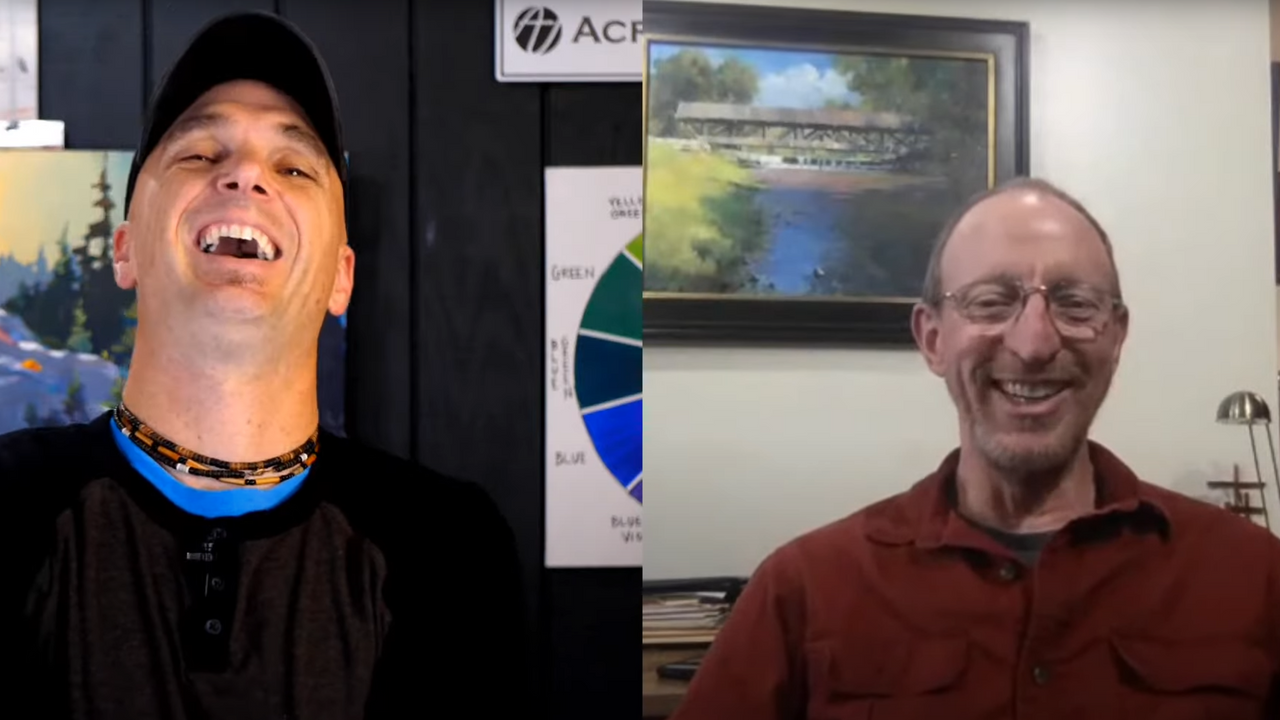You Asked Farley Your Painting Questions - Here's What He Said!

Last Friday for Week 2 of November's Journey for Members - Fields and Farms - we had the pleasure of joining Acrylic Artist Farley Lewis for a live painting demonstration. Afterwards, members were able to ask Farley all of their art-related questions. Here are the questions and answers from the livestream!
Members can access the replay of the livestream under My Courses --> The Journey --> Nov (Fields and Farms).
Linda: Is it a board you use rather than a canvas?
Farley: Yes she’s right and I use Pintura panels which you can get through the art houses. They’re made in Italy, you can get them from Jerry’s Artorama, places like that.
Sharon: Are you using a hog bristle brush?
Farley: Using a Princeton Dakota 6300 series brush. You can get those through art houses or blick or places like that.
Linda: Is your palette glass?
Farley: Well, it’s a tempered glass and I painted the backside of the glass midtone grey. (He actually places the palette inside of his Masterson Palette as well).
KJ: Farley, are you self-taught? What artist’s influence you? Who do you admire?
Farley: I really like John Stinger Sargent – he’s a master from the 1800s. My current list is William Hook, Mark Boedges, John McDonald – those guys are really good. And as far as being self taught, when I hear that term I think the only way you could be self taught in this day and age is if you lived in a cage. If you look at any other artists or any other paintings, you’re being influenced in some way. I try to take one workshop every other year. Travel someone, study under someone I admire and paint with ‘em.
Kim Smith-Chapman: Love the way the ground color is showing through. . . was it ochre?
Farley: Kim I used transparent Red Iron Oxide and Burnt Umbre for that particular background. I do backgrounds different a lot just because I like to have fun with them. Keep things interesting.
Doug Greenman: “A step lighter for the rock and a step darker for the shadow.” Did I hear that right?
Farley: Yes that’s right so rocks in a stream, I find them fairly easy to paint. You just take the stream color that you have and you mix it just a little bit lighter and that becomes the top of your rock and you mix it just a little darker and that becomes the shadow under the rock. The differences are pretty slight but if you get too drastic the rock doesn’t look like it’s underwater anymore.
Sandra Willoughby: I’m not sure whether I’m inspired or if I want to go back to bed and pull the covers over my head!
Farley: I would say we’re all on a journey and be proud of how far you’ve come. There’s times where I see somebody and I’m like wow I can’t do that, I don’t even know how to do that. But I try to stay positive, stay encouraged – God loves me even if my next painting is a total disaster.
Kim Smith-Chapman: How do you determine the focal point of a painting?
Farley: That’s a good question – it’s the thing that first grabs my eye when I see the scene. Whatever grabs my eye, that becomes the focal point. That’s the story I want to tell.
Rosemary C: Ever use any different mediums for textures?
Farley: Not really. Just again I use the heavy body sometime. And there’s a clear heavy body. Golden Heavy gel simi-gloss. And then sometimes I just use the heavy body paint like that. And the only heavy body paint that I have that I use regularly is the white. Because I use those for the highlights and it’s usually a real light color. Your eye is pulled to the highlight areas so using heavy body paint helps give it a bit of texture.
Rosemary C: Those soft atmospheric edges are terrific! Do you like to go with the edge of the shape over the background or background into the shape or both?
Farley: Rosemary that’s a great question. I do both. And I don’t do skies first and trees on top usually because you run the risk of looking like you cut a tree out and pasted it on top of the sky. Soft edges and hard edges – the difference is a big deal for me so I pay a lot of attention to edges.
Kim Smith-Chapman: Should every painting have a focal point?
Farley: Kim that’s a good question and I think every painting should have a story and I like to use the term focal area instead of focal point. Because sometimes the focal area is three fourths of your painting. If the story you’re telling is the misty afternoon air, your whole painting might be something that becomes the focus.
Colette Pitcher: Are you thinking temperature in the shadow? Warm light cool shadows for example?
Farley: Yes Colette you’re right on. I find that paying attention to temperature is what makes your lighting believable. Staying authentic to light is important. I want people when they look at my paintings to be able to go ‘Oh that’s a sunny day’ or ‘Oh that’s a cloudy day.’ But the way you do that is you be consistent with color temperature. Typically on a sunny day painting you have warm light and cool shadows and flip flop that for a cloudy day. When I’m mixing colors I ask myself two questions. Is the color I’m mixing darker or lighter? And is it warmer or cooler? I’m not thinking hue as much as I’m thinking those two things – value and temperature.
Kim Smith-Chapman: Can a painting have more than one focal point?
Farley: I tend to think of it like a movie – you have your main stars and you have your costars. If I look at painting I like to have one primary focus and two or three secondary focuses but the secondary focuses can’t compete with the star of the show. And to make sure the secondary focuses aren’t detracting from the primary ones, I’d make sure my biggest value contrasts are in the primary focal point.
Oty2012hy: Is there a specific message your paintings express to viewers?
Farley: That’s a really good question. I think that beauty in general is a gateway to the Divine. So people look at something really beautiful like Niagara falls – which by the way is the most popular destination in the US. Above all the Disney places in the world people go and stare at a waterfall for two or three days or two or three hours and they walk away refreshed. How does that work? But I believe that beauty by itself is a gateway into the divine. So whenever I’m out in nature or looking at photos, I’m looking for a glimpse of glory. That little piece of beauty that makes my heart sing. You don’t even have to be a religious person, it’s just something that kinda makes your spirit come alive. That’s the thing I want to try to capture in a painting.
Toni Carter: I’d like to ask Farley how he would give the impression of the high grasses being blown by good ground wind
Farley: I try to make my brushstrokes match the direction I see in front of me. So if the grass is blowing to the right I make my brushstrokes go to the right. Then the last little piece of detail is just a few little curved pieces of grass that are going in that direction. (He has a bunch of loose detail then adds some fine detail at the end).
Jan Young: Can you tell us your thinking about choice of blues?
Farley: I think you ought to find a blue you like and stick with it until you understand how it works and how it mixes. That’s what I did, I found a blue that I liked and I just used it til I learned it. But to me whether you use cobalt, ultramarine or something else I’m not sure it even matters much, I think they can all work for you.
Johnny: How do you decide whether to soften the edge with your finger vs your brush?
Farley: Whatever’s easiest at the moment pretty much. And as far as what edges to soften, if something is screamin' at me – it’s getting too much attention the edge is too sharp for where it is in the painting – that’s where I want to soften the edges. Especially around the outside. When we’re looking at something only 5-10% of it is in focus, the rest is blurred. Whenever we see a painting, I like to paint them that way.




